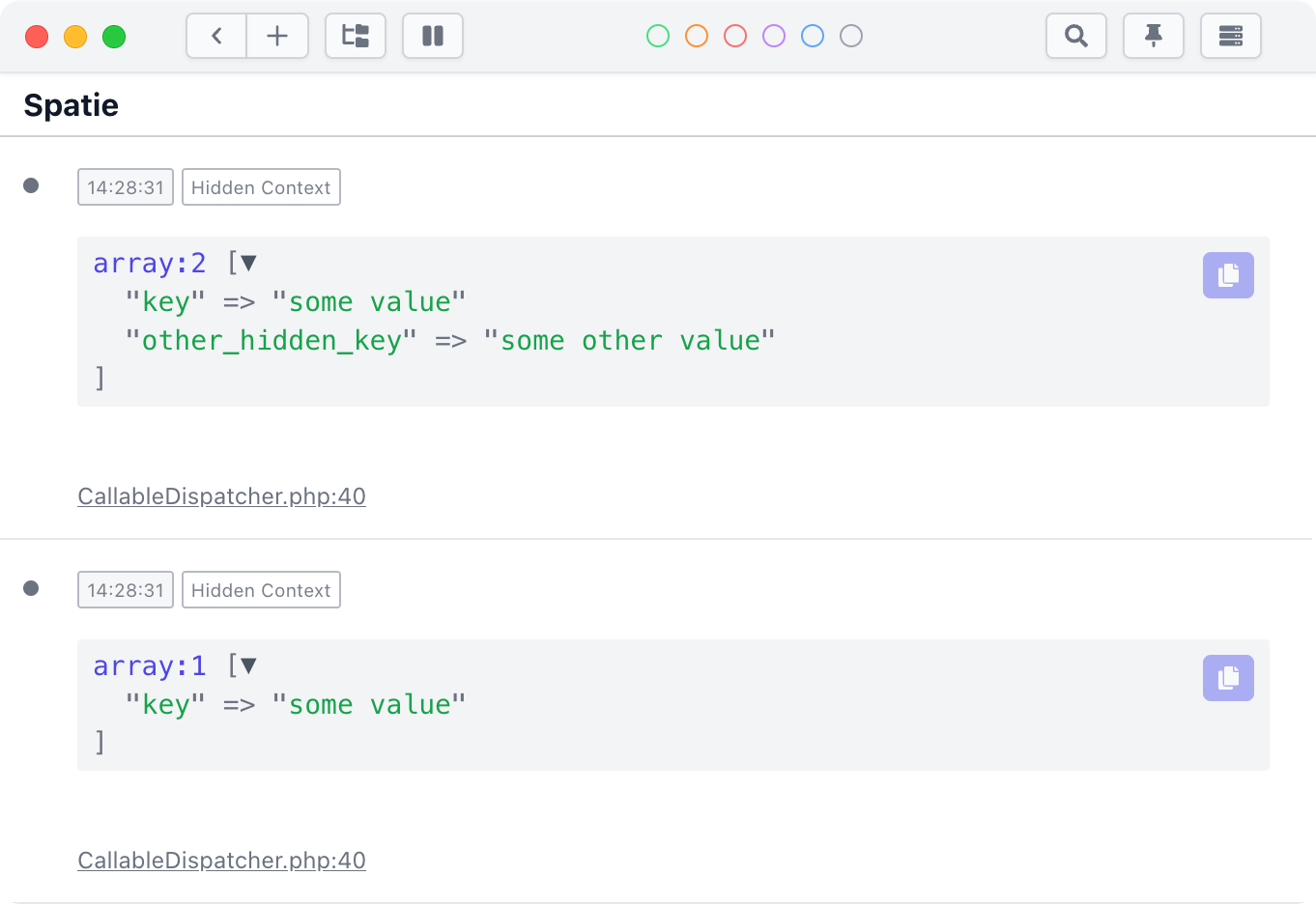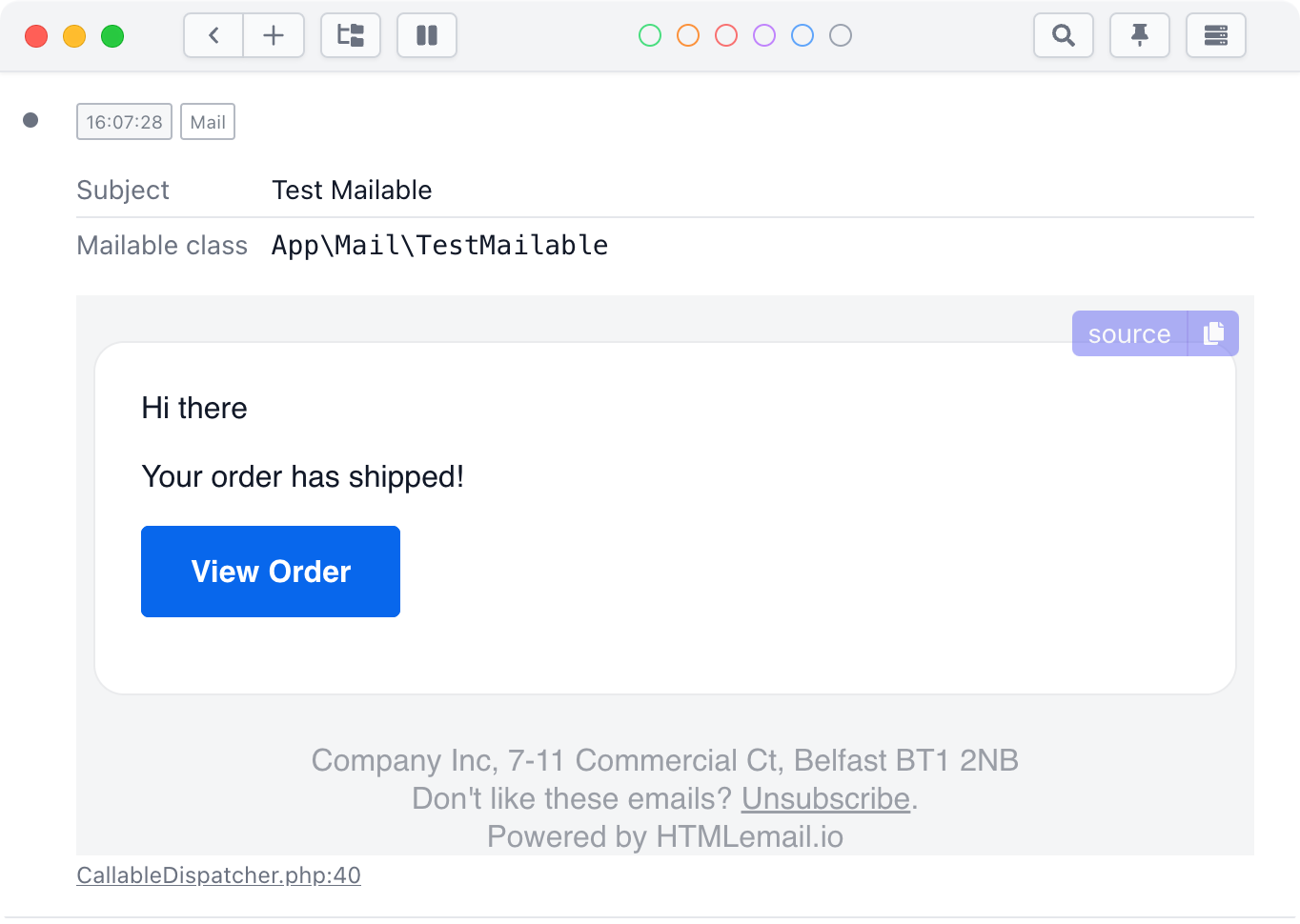Ray Methods in Laravel
Inside a Laravel application, you can use all methods from the framework agnostic version.
Additionally, you can use these Laravel specific methods. Sometimes you may want to log something to Ray and get the resulting return value of your closure instead of an instance of Ray. You can achieve this by adding a return value type to your closure. See the examples for showQueries() and countQueries() below. Any other methods that accept a closure will function the same way.
#Showing events
You can display all events that are executed by calling showEvents (or events).
ray()->showEvents(); event(new TestEvent()); event(new TestEventWithParameter('my argument'));

To stop showing events, call stopShowingEvents.
ray()->showEvents(); event(new MyEvent()); // this event will be displayed ray()->stopShowingEvents(); event(new MyOtherEvent()); // this event won't be displayed.
Alternatively, you can pass a callable to showEvents. Only the events fired inside that callable will be displayed in Ray.
event(new MyEvent()); // this event won't be displayed. ray()->showEvents(function() { event(new MyEvent()); // this event will be displayed. }); event(new MyEvent()); // this event won't be displayed.
#Showing jobs
You can display all jobs that are executed by calling showJobs (or jobs).
ray()->showJobs(); dispatch(new TestJob('my-test-job'));

To stop showing jobs, call stopShowingJobs.
ray()->showJobs(); dispatch(new TestJob()); // this job will be displayed ray()->stopShowingJobs(); dispatch(new MyTestOtherJob()); // this job won't be displayed.
Alternatively, you can pass a callable to showJobs. Only the jobs dispatch inside that callable will be displayed in Ray.
event(new TestJob()); // this job won't be displayed. ray()->showJobs(function() { dispatch(new TestJob()); // this job will be displayed. }); event(new TestJob()); // this job won't be displayed.
#Showing cache events
You can display all cache events using showCache
ray()->showCache(); Cache::put('my-key', ['a' => 1]); Cache::get('my-key'); Cache::get('another-key');

To stop showing cache events, call stopShowingCache.
#Showing context
Laravel 11 introduced the ability to set context.
You can display all context using Ray's context method.
ray()->context(); // displays all context ray()->context('key', 'key2'); // displays only the given keys

Context can also be invisible. You can display those values using the hiddenContext method.
ray()->hiddenContext(); // displays all hidden context ray()->hiddenContext('key', 'key2'); // displays only the given hidden keys

#Handling models
Using the model function, you can display the attributes and relations of a model.
ray()->model($user);

The model function can also accept multiple models and even collections.
// all of these models will be displayed in Ray ray()->model($user, $anotherUser, $yetAnotherUser); // all models in the collection will be display ray()->model(User::all()); // all models in all collections will be displayed ray()->model(User::all(), OtherModel::all());
Alternatively, you can use models() which is an alias for model().
#Displaying mailables
Mails that are sent to the log mailer are automatically shown in Ray, you can also display the rendered version of a specific mailable in Ray by passing a mailable to the mailable function.
ray()->mailable(new TestMailable());

#Showing which views are rendered
You can display all views that are rendered by calling showViews.
ray()->showViews(); // typically you'll do this in a controller view('welcome', ['name' => 'John Doe'])->render();

To stop showing views, call stopShowingViews.
#Displaying markdown
View the rendered version of a markdown string in Ray by calling the markdown function.
ray()->markdown('# Hello World');

#Displaying collections
Ray will automatically register a ray collection macro to easily send collections to ray.
collect(['a', 'b', 'c']) ->ray('original collection') // displays the original collection ->map(fn(string $letter) => strtoupper($letter)) ->ray('uppercased collection'); // displays the modified collection

#Usage with a Stringable
Ray will automatically register a ray macro to Stringable to easily send Stringables to Ray.
Str::of('Lorem') ->append(' Ipsum') ->ray() ->append(' Dolor Sit Amen');

#Displaying environment variables
You can use the env() method to display all environment variables as loaded from your .env file. You may optionally pass an array of variable names to exclusively display.
ray()->env(); ray()->env(['APP_NAME', 'DB_DATABASE', 'DB_HOSTNAME', 'DB_PORT']);
#Using Ray with test responses
When testing responses, you can send a TestResponse to Ray using the ray() method.
ray() is chainable, so you can chain on any of Laravel's assertion methods.
// somewhere in your app Route::get('api/my-endpoint', function () { return response()->json(['a' => 1]); }); // somewhere in a test /** test */ public function my_endpoint_works_correctly() { $this ->get('api/my-endpoint') ->ray() ->assertSuccessful(); }

To enable this behaviour by default, you can set the send_requests_to_ray option in the config file to true.
#Showing HTTP client requests
You can display all HTTP client requests and responses using showHttpClientRequests
ray()->showHttpClientRequests(); Http::get('https://example.com/api/users');

To stop showing HTTP client events, call stopShowingHttpClientRequests.
Alternatively, you can pass a callable to showHttpClientRequests. Only the HTTP requests made inside that callable will be displayed in Ray.
Http::get('https://example.com'); // this request won't be displayed. ray()->showHttpClientRequests(function() { Http::get('https://example.com'); // this request will be displayed. }); Http::get('https://example.com'); // this request won't be displayed.